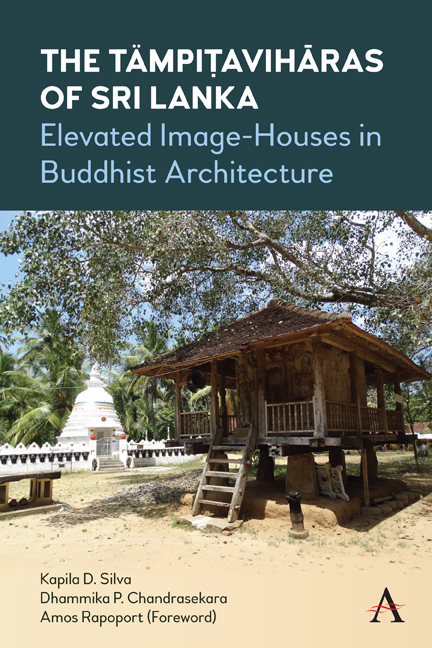Western Province
Published online by Cambridge University Press: 16 December 2021
Summary
Aṭupotdeṇiya Ṭӓmpiṭavihāra, Gampaha District
Folklore says that the revenue collector of the Hāpiṭigam Kōralē area during the Dambadeṇi period constructed this ṭämpiṭavihāra. The village where it is located was the main supplier of ola leaf that were used for manuscripts during that era. The ṭämpiṭavihāra has an unusually long cella, both exterior and interior walls of it had murals. Only faint traces of the murals on the exterior wall remain. The cella has a seated Buddha image, two standing Buddha images, and images of gods Vishnu and Skandha. The ṭämpiṭavihāra is situated 7.3 km north of Mīrigama town, off Mīrigama-Giriulla-Alawwa road.
Kӓkulandaḷa Ṭӓmpiṭavihāra, Kalutara District
This vihara is on an elevated location on Kalavellawa road, beyond the town of Agalawatta. It is assumed that Siriwardana Dēvapatirāja, a minister to either/both Parākramabāhu VI (1412– 1467) or Bhuvanikabāhu VI (1470– 1478) of the Kōṭṭē period, had sponsored the construction of the ṭämpiṭavihāra with the guidance of a monk named Kuragama Thērō. There are images of the minister and the monk painted on either side of the door on the inner surface of the front wall of the ätulgäba. In addition, there are murals of arhants, five on each wall, and a single seated image of the Buddha in the cella. These murals and the image may belong to the nineteenth century, based on their stylistic traits. The roughly square-shaped image-chamber is raised just two feet above the ground by nine short pillars and the ambulatory is placed on the ground level. There is no additional maṇḍapa in the front of the structure. The ambulatory has a parapet wall on the back and sides and its front is fully open, except for two wooden columns supporting the front eave of the hip-roof. Seven stone columns, four on the corners and one each on the sides and the back support the rest of the roof eaves.
Mӓṭikoṭamulla Ṭӓmpiṭavihāra, Gampaha District
This ṭämpiṭavihāra is situated in a vihara on Ässella road off Waḍumulla junction, about 2.5 km off Vēyangoḍa-Minuwangoḍa road. It was built by the local community in 1862. This date indicates that the ṭämpiṭavihāra tradition continued into the end of the nineteenth century. The ṭämpiṭavihāra is constructed on a short plinth. Only the sanctum is raised on stone pillars.
- Type
- Chapter
- Information
- The Tämpitaviharas of Sri LankaElevated Image-Houses in Buddhist Architecture, pp. 163 - 173Publisher: Anthem PressPrint publication year: 2021



